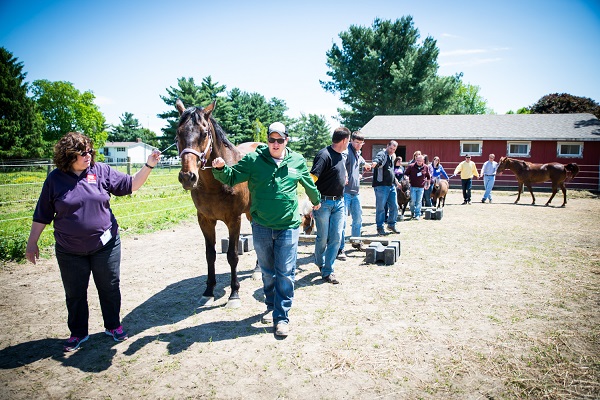“Not finance. Not strategy. Not technology. It is teamwork that remains the ultimate competitive advantage, both because it is so powerful and so rare.” – Patrick Lencioni

A group of individuals from the same organization walked out into the small pasture with the task of moving a group of 4 horses from one corner of the pasture to another. The horses represented clients of the group’s organization. As the group walked out to interact with the clients, we immediately could see the dysfunction within the group. The individual group members were scattered around the pasture and the horses directly reflected this by also moving themselves to different areas of the pasture. During the experiential team building exercise, it became more and more apparent that the group lacked one of the key components of having a healthy functional team – trust.
Did you know that teams experiencing dysfunction and without an effective leader can cost businesses billions of dollars a year in lost revenue? According to an article on Forbes.com, “Gallup estimates that lost productivity due to absence, illness and work problems costs U.S. businesses in excess of $350 billion a year.” (Connor, Forbes.com, 2014). While there are certainly many causes of employee stress (direct supervisor, finances, personal issues among the top), having a manager who is not an effective leader can create the perfect environment for a dysfunctional team to thrive.
What are the signs of a dysfunctional team?
When teams are in dysfunction, it looks like the group we saw with the horses – individuals wandering around, not communicating, not looking for solutions, and certainly not working together towards the common goal. Because there is a lack of trust within a dysfunctional team, there is lack of clear communication – often due to a fear of healthy conflict. This leads to group members having a lack of commitment to the goals and objectives of the team and organization. They assume that other members of the group are not committed to the goals so why should they be committed? Dysfunctional teams are challenged with holding themselves and team members accountable – again due to a lack of trust. And ultimately, because the group is in constant conflict and stress, they are not focused on achieving organizational results. These are the five areas that Patrick Lencioni identifies in his book “The Five Dysfunctions of a Team.”
This team showed classic signs of a team stuck in the storming stage of group development (Tuckman’s Stages of Group Development) which can quickly lead to dysfunction. This is a time that involves a great deal of emotion and group members are trying to figure out their role as well as who is the leader. For this group, they had experienced a change in leadership only a few months prior to coming to Wager’s Way. Unfortunately, the group was in the early stages of storming so dysfunction was quite extensive. They only were with us for a short demonstration workshop, so we didn’t have time to dive into helping them move out of storming. However, through their additional experiential work with the horses, they began to see how they were not working together and their new leader realized she needed to step more confidently into that role. From that short experience with the equine co-facilitators, the leader also recognized she needed to look more closely at whether she had the right people on her team and that she could benefit from additional leadership coaching in order to move her team from storming to performing. She had seen first-hand the dysfunction within her team and was willing to take steps to find a solution. The organization’s leader ended up reorganizing her staff to bring on new team members who were willing to work together and brought the new team out for a full day of team development with Wager’s Way. The team focused on strengths and learning about each other to maximize how they worked together to achieve organizational goals. That team is still together, functioning well and has been highly successful in growing the membership of their organization.
Is your team struggling with getting results due to lack of trust, ineffective communication or challenges in leadership? Contact us to get your team moving forward!
